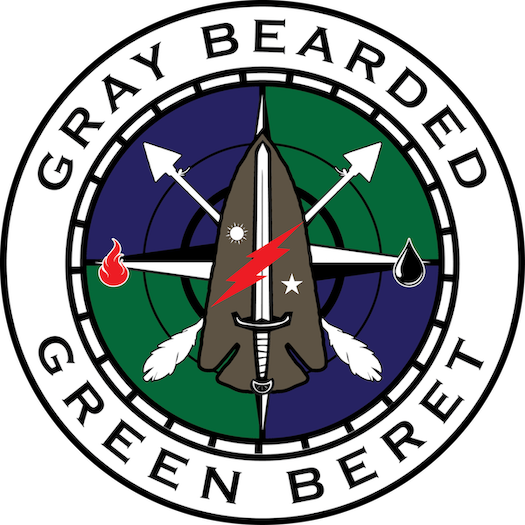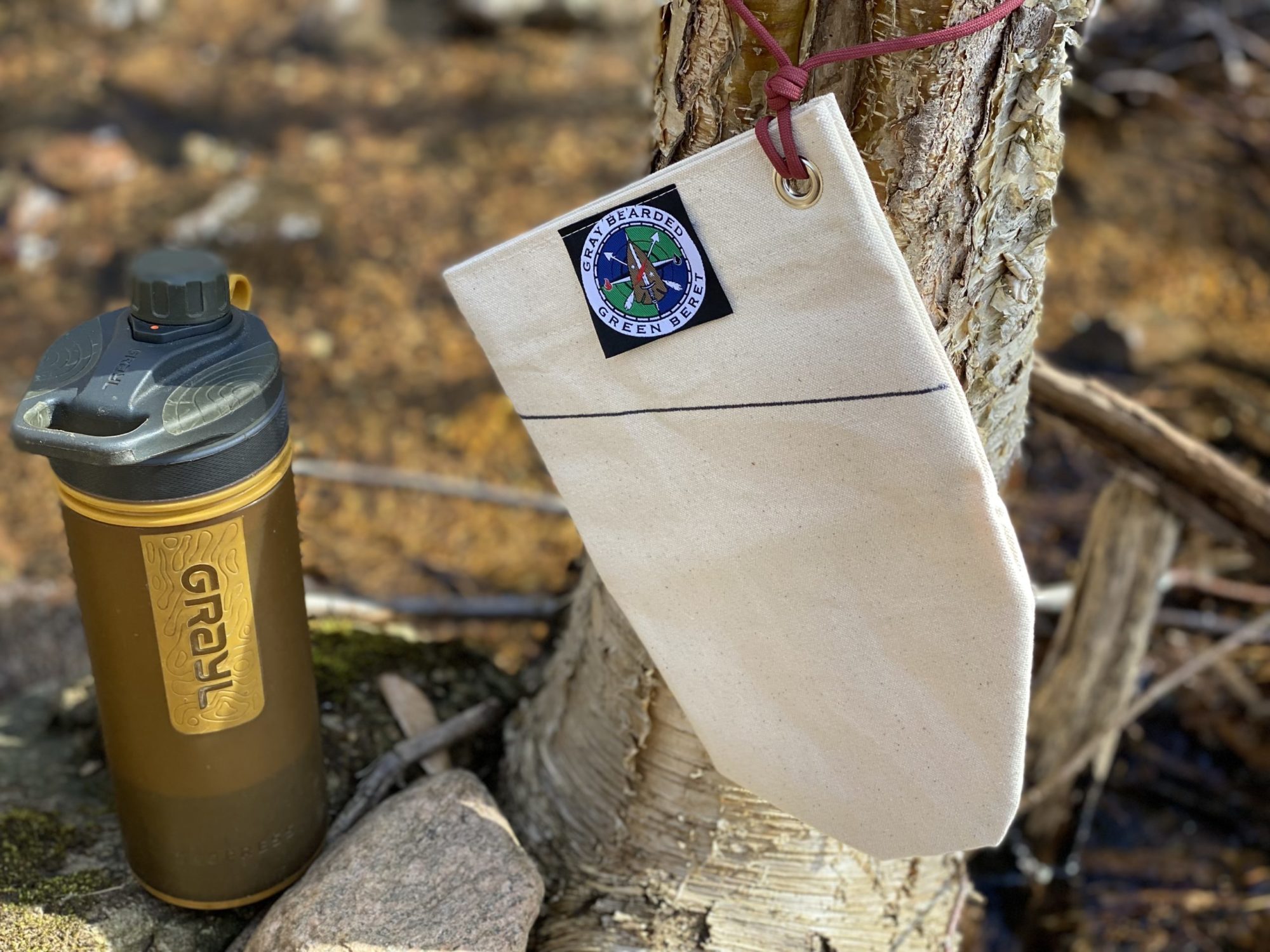Water and Food Kits
For the water kit, all you really need is a way to gather and store it and a way to make it safe to drink. Typically a container like a water bottle is used for gathering and storing the water. There are several ways it could be made safe to drink. You can use a commercial filter or purifier, chemical disinfectant, or thermally disinfect it by boiling. All disinfection techniques can be more effective when used with a pre-filter or clarifier.
Water bottles used in a wilderness setting should be single- walled (non-insulated) metal containers. This allows you to always have boiling directly in the bottle as a contingency, regardless of the primary disinfection method you choose. Double-walled (insulated) bottles have air trapped between the walls that will explode if heated in a fire. Although you could boil in plastic in an emergency, it would not be a good long-term solution and should be avoided from the start.

Water bladders are good for carrying large amounts of water, but should never be your primary container. They are more fragile than the plastic water bottles and less versatile than the single-walled metal water bottle.
A water bottle carrier is a convenient accessory that allows you to carry your water without having to always carry your pack. This helps ensure that you always have it on you when you need it.
There are a variety of commercial filters available. Some will only filter, while others will filter and purify.
FILTERS HANDLE BACTERIA AND PROTOZOA, WHILE PURIFIERS HANDLE BACTERIA, PROTOZOA, AND THE MUCH SMALLER VIRUSES.

Pre-filtering, or clarifying, the water to reduce turbidity and remove suspended particulates will make any disinfection method you choose more effective. The result will be a more palatable water as well. A simple pre-filter like a millbank bag will also greatly reduce the amount of particulates that go through your commercial filter or purifier, extending it’s life. A millbank bag also usually costs less than a replacement filter.
It could also be pre-filtered with a simple cotton bandana or cotton GP Cloth. The pores of the cotton are small enough to remove particulates down to a reasonably effective size, but not as well as the millbank bag which is a tightly-woven canvas.
PRE-FILTERING OF ANY TYPE IS FOR CLARIFICATION OF THE WATER ONLY AND DOES NOT MAKE IT SAFE TO DRINK.
Recommended Water Kit:
- Single-walled Metal Water Bottle
- Water Bottle Carrier
- Nesting Cup with Lid
- Commercial Filter/Purifier
- Millbank Bag
- GP Cloth
Survival Food Kit
It has been said that you can go three weeks without food, and while that may be true, you can live, but you will be suffering long before that. Why do that when you can anticipate that need ahead of time and pack accordingly?
Every time you go out, pack food and snacks for at least the amount of time you expect to be out there. Nobody goes camping or hiking without any food, and that is likely where an emergency would happen, so you should already have some food with you. At a minimum, any emergency kit should have emergency rations in it.
It’s as if there is this idea that in order for it to be survival, you have to be down to using sticks and rocks to get by. There are no rules that state that you have to trap, hunt, or fish for all your food in an emergency, so don’t pack as if there is.
Is surviving an emergency somehow less valuable if you anticipated needs, prepared for them, and had resources for the emergency you lived through? Is it okay if you survived with pre-packed traps, snares, and fishing gear but not okay if you packed emergency rations along with those? That doesn’t pass critical thinking. It’s worth saying again:
IMPROVISING IS SOMETHING WE DO WHEN WE FIND OURSELF UNPREPARED OR UNDERPREPARED. WE DON’T PLAN TO IMPROVISE.

Having said that, you are certainly limited to the amount of rations you can carry. You should also have a means of procuring food after those rations run out if you have not been rescued or self-rescued by that time.
You aren’t actively going hunting for deer or wild turkey. You have no refrigeration and can’t eat all of that in one or two sittings, so most will likely just draw predators until it goes to waste. You are going for the smaller critters and fish that can be cooked and consumed in one sitting.
Passive fishing and trapping will always be a more efficient use of time and energy. Think about multiple being put out to catch smaller fish and game. Once they are in place, they are working for you while you do other tasks. The more traps, the better.
“TWO IS ONE, ONE IS NONE, TEN OR MORE IS DINNER FOR SURE.”
For planning purposes, expect to get a 10% return on your traps, and only after a 3-day “soak”. For every ten you set out, expect to get one critter or fish. Some days may be better, some maybe not even that. What you don’t want to do is rely on one or two traps to feed you consistently. Statistically, you will just go hungry more often than not.
Soaking simply means that often with trapping, the set needs a few days for your scent to dissipate enough that animals are less likely to avoid the trap and area. You don’t need the heavy body gripping traps. It’s not practical to carry ten of any size of those, they are too heavy, bulky, and awkward to pack. Even the small-sized 110’s are too large to catch most of the smaller game you are going for.
You should also consider what environment you are going into. Life begins at the waters edge. Fish, frogs, crayfish, and turtles will be in the water; land animals and birds will be coming to drink water. Set up your kit accordingly and plan to set traps for land and in the water.
Carry an assortment of traps rather than one type. Survival snares, rat traps, and Mechanical Fisher Yo-Yo’s are great choices. Add a small packet of peanut butter to your trap kit. Everything in the wild loves peanut butter, and it is usual something that is bot foreign and irresistible to them.

With these, you can quickly set out a small trap line and put that to work for you before you ever even break into your emergency rations. You can eat your rations knowing you are already working on getting more food to replace them, less time spent hungry that way.
A variety of fishing lures and tackle should be carried as this is often a readily available resource. After all, you need a water source anyway. The GB2 Hunting and Fishing BOSS Kit has a good assortment of fishing tackle that can be used and has one Mechanical Fisher Yo-Yo included.
A working knowledge of edible plants in your area can supplement your diet well if you take the time to learn them now and are able to positively identify them. What you don’t want to do is pack a field manual and try to learn them from a book in an emergency when you are cold, wet, tired, and hungry. Thats the wrong way to go about accessing this resource.
In addition, knowing how to make and use a variety of primitive traps can really supplement your trapping kit well and increase your chances of getting food. The basics of edible plants and over ten primitive traps are taught in the foundational GB2 Wilderness Skills Course.

If you do catch fish or game, you will need a way to cook it. Most of the time you can use the nesting cup from your water kit, but the convenience of a bush pot is hard to beat. Plus that pot can be used to make beneficial soups and stews and process more water. Everything should be souped or stewed in a survival situation to get the most out of it.
If you are going to actively hunt, hunt for fish and frogs at night on the waters edge. A good fish/frog gig that you can attach the the end of a wooden pole you make out in the wild is a great addition to your kit that is worth the weight.
Opportunistic hunting, when you happen to see small game while setting out your traps or going to get water, is also worthwhile.
Recommended Food Kit:
- Bush Pot
- Fishing and Hunting BOSS Kit
- Emergency Rations
- Survival Snares
- Rat Traps
- Mechanical Fishing Reels (Yo-Yo’s)
- Frog/Fish Gig
- Small Packet of Peanut Butter
Join us for a Live Course or Workshop here. For more info see my downloadable content here or books and PDFs here.
Be Prepared First. We hope to see you around our campfire soon!
-Joshua


